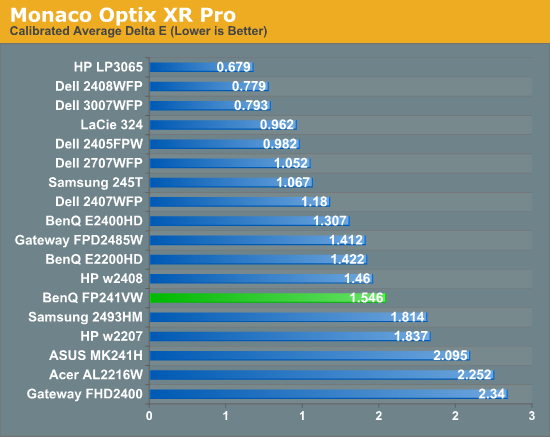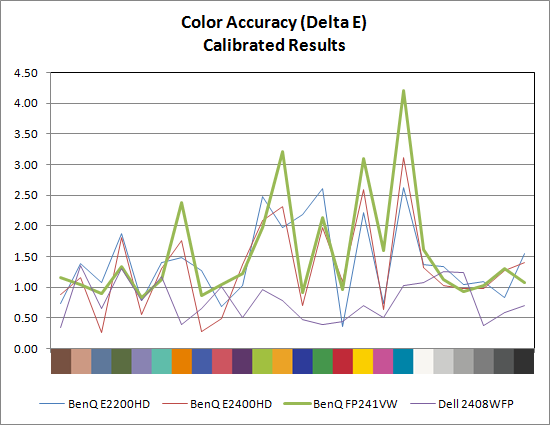Color Accuracy
Imaging professionals definitely like to have accurate colors, and the best way of assuring that your display shows the proper colors is to use a colorimeter and calibration software. However, not everyone has access to such tools and many users are unwilling to spend over $200, so we calibrate and test the various LCDs. We didn't perform a thorough evaluation of color accuracy on the FP241VW, so we will limit our Delta E comparison to calibrated performance where we target a white level of ~200 nits - anything more than that is too bright in our opinion. The FP241VW actually ended up at 270 nits, but that won't substantially affect any of the scores. Before we get to the results, here are the display settings we used on the BenQ LCDs. We let the LCDs stabilize for at least one hour before performing measurements. We will compare results with the Dell 2408WFP, which so far has achieved the best overall color accuracy of any LCD we have tested, as well as the previous two BenQ LCDs.
| LCD Brightness and Contrast Settings | ||
| Standard Calibrated (~200 nits) | Calibrated for Print (~100 nits) | |
| BenQ E2200HD | 65 Brightness, 50 Contrast "Normal" (95-95-95 RGB) |
20 Brightness, 50 Contrast "Normal" (95-95-95 RGB) |
| BenQ E2400HD | 73 Brightness, 50 Contrast "Normal" (94-94-91 RGB) |
30 Brightness, 50 Contrast "Normal" (94-94-91 RGB) |
| BenQ FP241VW | 35 Brightness, 50 Contrast (270 nits) "Normal/sRGB" (47-48-45 RGB) |
N/A |


After calibration, the FP241VW still fails to come anywhere close to the Dell 2408WFP - and in fact it doesn't even match the accuracy of the less expensive E2400HD. That said, it's interesting to note that the color accuracy curves for all three BenQ LCDs are extremely similar, to the point where I now have to wonder if backlighting has a far greater impact on color accuracy than I previously thought. It makes sense that better backlighting would allow the panels to achieve better color accuracy, but I don't have any evidence for this assertion other than the above chart. Anyone serious about color accuracy is probably going to want an average Delta E of around 1.0 or less post-calibration. So far, only S-PVA and S-IPS panels achieve that goal, although it's possible a better backlight would allow the A-MVA display to match the other displays. Note also how the bottom half of the above chart is dominated by LCDs that use TN panels.










114 Comments
View All Comments
JarredWalton - Wednesday, June 17, 2009 - link
The glossy vs. matte debate is one of those areas that comes down to personal preference. Me, I really dislike glossies - and I know plenty of others that feel the same. However, I also know people that prefer glossy displays. More power to 'em, but I'm not going to encourage the trend. :-)photoguru - Wednesday, June 17, 2009 - link
- Vizio 32" LCD Full HDTV (VO32LFHDTV10A) - $527 at Sam's Club USI've swapped out my 20" Apple Cinema Display for this 32" TV and I was completely shocked at the quality of the panel. If you run your image through one of the HDMI inputs text looks crisp and it even can run PIP for watching TV while working.
I am a creative director and so I spend a lot of time staring at screens working on print, web, and television programs... I would like to have an LED back lit screen but for the money this thing is ridiculous.
iwodo - Wednesday, June 17, 2009 - link
Are there any major different between panel type in terms of power consumption?And i really do hope either TN solve their "in-viewable" vertical viewing angle. ( Sorry "poor" in your article simply would not justify it ) with special coating that has been developed for a long time but there are yet wide spread of use.
Or E-IPS will give the best performance per dollar. TN is possible the worst invention for Display Monitor history in All times.
aceh0 - Wednesday, June 17, 2009 - link
The FP241VW launched in early 2007 and had nearly a two year run. Street pricing was under 500$ near the end of the product life cycle.
evilspoons - Wednesday, June 17, 2009 - link
I found an missing-box demo model at a local computer store for $250, but I passed on it seeing the noticable lag between moving the mouse and seeing the cursor respond. That, and the asinine stand, made me keep looking. I hate my 22" Gateway monitor (it does a terrible job dithering) but I'm not going to spend money on virtually the same thing as a replacement, either (i.e. any other new monitor).I tried to buy an IPS 24" HP monitor a few months ago (lp2475w) but the distributor I attempted to order from jacked the price up $200 (from $700 Canadian to nearly $900 - ouch) in the time between me placing the order and it shipping, so I just cancelled.
Then... I just gave up entirely because I realize I spend 99% of my computer time on my MacBook Pro now and I have to live with its LCD. Ha.
erple2 - Wednesday, June 17, 2009 - link
Why not just buy directly from hp? They have it for 729 Canadian dollars. Was it really that much cheaper when you got it from the distributor than directly from hp?JarredWalton - Wednesday, June 17, 2009 - link
Sorry for the error; I have clarified things now I hope. You're right that it first came out in 2007, but I believe it was announced early 2007 and actually available round about Sept/Oct. Anyway, it is discontinued, unfortunately just around the time the pricing was becoming desirable. You can find them online still at some places, but no major resellers carry them anymore so you'll have to take a bit of a chance if you buy one these days.IlllI - Wednesday, June 17, 2009 - link
"The vast majority of LCDs these days are TN panels, and the trend appears to be moving even more in that direction. With a soft economy, many are looking for any way to save money, and even those who really like quality displays may be willing to settle for a less expensive TN panel"while TN is indeed cheapest, you can actually get a 22in e-ips lcd for around (or sometimes under) $200. while not as good as the more expensive ips panels, it is (in my opinion) better quality than TN. certainly, you guys know of it? http://forums.anandtech.com/messageview.aspx?catid...">http://forums.anandtech.com/messageview.aspx?catid...
Grooveriding - Wednesday, June 17, 2009 - link
It's a real shame the tendency towards TN these days. Most consumers are just not informed as to the much more satisfying experience given by PVA/IPS panels.If you can get someone to sit in front of a TN and high quality monitor side by side that is usually enough to settle it, of course for some image quality is not a concern. For the enthusiast hardware user though, it usually is.
I have an older LG246WP-BN which is a fantastic screen with great quality as well as a Dell 2408. Reading this article has made me think my eyes are bad though, as I prefer the IQ on my LG to the Dell, which according to this review ought to be superior with it's more modern panel tech.
The0ne - Thursday, June 18, 2009 - link
Consumers are mostly going to want something average with a good low price. This isn't going to go away. And on most of their part they don't really care whether it's a TN panel or better because as long as it's "clear" and they like it then they'll buy it.I'll use myself as an example. I have 2 Dell 3007wfp-hc, 1 2407wfp, 2 22" viewsonics, 1 Acer 24" with TN, and 1 Acer 22" with TN. My main computer uses the 3007's of course but even when I switch to the other panels I rarely care. That's because the content I'm working with really doesn't require the extra 5-15% gamut, high contrast and so forth.
Now if I really really care about colors, brightness, details and what have you then sure I'll spend the extra money on better panels and features. But then again why wouldn't I spend it on the medical LCDs :)
I am pretty sure many of you commenting about wanting/needing a better than TN panel actually don't care whether you do or not on a daily basis. If you do you'll be a stickler like my co-worker who spends time paying attention to ghosting, blurs, etc EVERY time he uses his TV. I'm pretty sure many of you don't do this nor have the time to do this. If you do then....well, no comment. :)